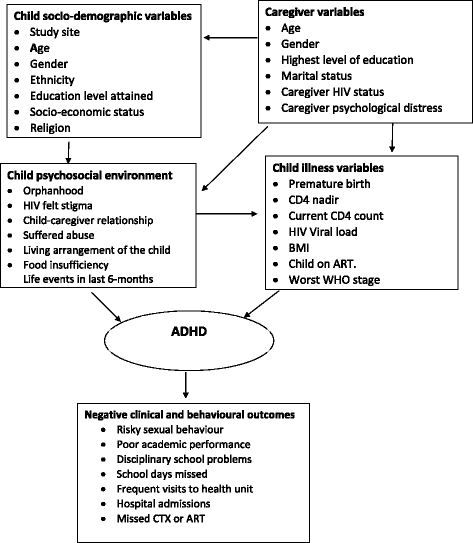Prevalence and correlates for ADHD and relation with social and academic functioning among children and adolescents with HIV/AIDS in Uganda
- PMID: 28938881
- PMCID: PMC5610431
- DOI: 10.1186/s12888-017-1488-7
Prevalence and correlates for ADHD and relation with social and academic functioning among children and adolescents with HIV/AIDS in Uganda
Abstract
Background: Aim of this study was to determine the prevalence of attention-deficit/hyperactivity disorder (ADHD), its associated correlates and relations with clinical and behavioural problems among children and adolescents with HIV/AIDS (CA-HIV) attending five HIV clinics in central and South Western Uganda.
Methods: This study used a quantitative design that involved a random sample of 1339 children and adolescents with HIV and their caregivers. The Participants completed an extensive battery of measures including a standardized DSM-5 referenced rating scale, the parent version (5-18 years) of the Child and Adolescent Symptom Inventory-5 (CASI-5). Using logistic regression, we estimated the prevalence of ADHD and presentations, correlates and its impact on negative clinical and behavioural factors.
Results: The overall prevalence of ADHD was 6% (n = 81; 95%CI, 4.8-7.5%). The predominantly inattentive presentation was the most common (3.7%) whereas the combined presentation was the least prevalent (0.7%). Several correlates were associated with ADHD: socio-demographic (age, sex and socio-economic status); caregiver (caregiver psychological distress and marginally, caregiver educational attainment); child's psychosocial environment (quality of child-caregiver relationship, history of physical abuse and marginally, orphanhood); and HIV illness parameters (marginally, CD4 counts). ADHD was associated with poor academic performance, school disciplinary problems and early onset of sexual intercourse.
Conclusions: ADHD impacts the lives of many CA-HIV and is associated with poorer academic performance and earlier onset of sexual intercourse. There is an urgent need to integrate the delivery of mental health services into routine clinical care for CA-HIV in Sub-Saharan Africa.
Keywords: ADHD; Children/adolescents; Correlates; HIV; Prevalence.
Conflict of interest statement
Ethics approval and consent to participate
This study was conducted in Uganda under the authorization HS 1601 approved by the Science and Ethical Committee of the Uganda Virus Research Institute and the Uganda National Council of Science and Technology. Consent to participate in this study was obtained from caregivers and assent from children and adolescents.
Consent for publication
Not applicable.
Competing interests
Dr. Gadow is shareholder in Checkmate Plus, publisher of the Child and Adolescent Symptom Inventory-5. The other authors declare that they have no competing interests.
Publisher’s Note
Springer Nature remains neutral with regard to jurisdictional claims in published maps and institutional affiliations.
Figures
Similar articles
-
Prevalence, correlates for early neurological disorders and association with functioning among children and adolescents with HIV/AIDS in Uganda.BMC Psychiatry. 2019 Jan 21;19(1):34. doi: 10.1186/s12888-019-2023-9. BMC Psychiatry. 2019. PMID: 30665382 Free PMC article.
-
Health-related quality of life in children and adolescents who have a diagnosis of attention-deficit/hyperactivity disorder.Pediatrics. 2004 Nov;114(5):e541-7. doi: 10.1542/peds.2004-0844. Pediatrics. 2004. PMID: 15520087
-
Exploration of the understanding and etiology of ADHD in HIV/AIDS as observed by adolescents with HIV/AIDS, caregivers and health workers- using case vignettes.Afr Health Sci. 2018 Sep;18(3):488-495. doi: 10.4314/ahs.v18i3.4. Afr Health Sci. 2018. PMID: 30602979 Free PMC article.
-
Systematic Review and Meta-Analysis: Attention-Deficit/Hyperactivity Disorder Symptoms in Children With Neurofibromatosis Type 1.J Am Acad Child Adolesc Psychiatry. 2025 Apr;64(4):447-462. doi: 10.1016/j.jaac.2024.09.011. Epub 2024 Dec 19. J Am Acad Child Adolesc Psychiatry. 2025. PMID: 39709008
-
Do parents and children agree on rating a child's HRQOL? A systematic review and Meta-analysis of comparisons between children with attention deficit hyperactivity disorder and children with typical development using the PedsQLTM.Disabil Rehabil. 2019 Feb;41(3):265-275. doi: 10.1080/09638288.2017.1391338. Epub 2017 Oct 23. Disabil Rehabil. 2019. PMID: 29057670
Cited by
-
Prevalence of behavioral disorders and attention deficit/hyperactive disorder among school going children in Southwestern Uganda.BMC Psychiatry. 2019 Apr 3;19(1):105. doi: 10.1186/s12888-019-2069-8. BMC Psychiatry. 2019. PMID: 30943981 Free PMC article.
-
Prevalence, correlates for early neurological disorders and association with functioning among children and adolescents with HIV/AIDS in Uganda.BMC Psychiatry. 2019 Jan 21;19(1):34. doi: 10.1186/s12888-019-2023-9. BMC Psychiatry. 2019. PMID: 30665382 Free PMC article.
-
Prevalence, Risk Factors, and Negative Outcomes of Anxiety and Depressive Disorders among HIV-Infected Children and Adolescents in Uganda: CHAKA Study 2014-2017.Psychiatry J. 2022 May 5;2022:8975704. doi: 10.1155/2022/8975704. eCollection 2022. Psychiatry J. 2022. PMID: 35572346 Free PMC article.
-
The prevalence of attention-deficit hyperactivity disorder and its associated factors among children in Ethiopia, 2024: a systematic review and meta-analysis.Front Child Adolesc Psychiatry. 2024 Aug 23;3:1425841. doi: 10.3389/frcha.2024.1425841. eCollection 2024. Front Child Adolesc Psychiatry. 2024. PMID: 39844859 Free PMC article.
-
Psychiatric Disorders in Adolescents Living with HIV and Association with Antiretroviral Therapy Adherence in Sub-Saharan Africa: A Systematic Review and Meta-analysis.AIDS Behav. 2021 Jun;25(6):1711-1728. doi: 10.1007/s10461-020-03100-z. Epub 2020 Nov 20. AIDS Behav. 2021. PMID: 33216245
References
-
- UNAIDS . Global Fact Sheet. 2013.
-
- Uganda AIDS Commission . The Uganda National HIV and AIDS Strategic Plan 2015/2016–2019/2020. Kampala: Uganda AIDS Commission; 2015.
-
- World Health Organisation . Treat all people living with HIV, offer antiretrovirals as additional prevention choice for people at “substantial” risk. 2015.
MeSH terms
Grants and funding
LinkOut - more resources
Full Text Sources
Other Literature Sources
Medical
Research Materials


